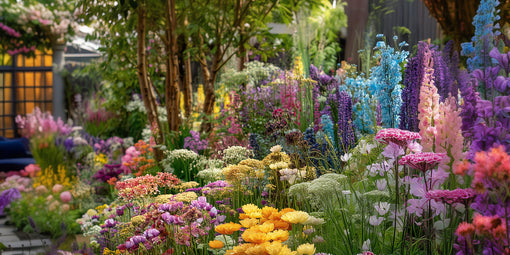
- Article published at:
Drawer menu
Are you ready to learn all about the beautiful and versatile flower; chrysanthemum? This charming flower has been beloved for centuries, and it's no wonder why!
Not only does it come in many colours and shapes, but it also has a rich cultural significance and numerous health benefits. In this post, we'll cover everything from growing tips to medicinal properties, as well as fun facts and recipes. So grab a cup of chrysanthemum tea and let's dive in!

Did you know that chrysanthemums are sometimes called "mums" for short? It's a fitting nickname for these flowers, which are known for their warm and welcoming appearance.
Chrysanthemums come in a wide range of colours, from classic white and yellow to bold shades of pink and purple. Plus, they're available in a variety of shapes and sizes - some chrysanthemums have flat petals, while others are more pompom-like.
If you're thinking about growing chrysanthemums in your garden, keep in mind that they prefer full sun and well-draining soil. And don't forget to deadhead them regularly to encourage more blooms!
Chrysanthemums aren't just pretty flowers - they also have a rich cultural significance. In Japan, for example, chrysanthemums are associated with the imperial family and are often used in art and symbolism.
In China, chrysanthemums are a symbol of autumn and are often depicted in paintings alongside other seasonal motifs. And did you know that chrysanthemums are also the birth flower for November? If you're looking for a meaningful gift for someone born in November, consider a bouquet of chrysanthemums.
With so much history and symbolism attached to them, it's no wonder that chrysanthemums have become such beloved flowers around the world.

Not only are chrysanthemums beautiful and culturally significant, but they also have a variety of health benefits. Chrysanthemum tea, for example, is a popular beverage in China and is believed to have a range of medicinal properties.
Some studies suggest that chrysanthemum tea can help reduce inflammation, lower blood pressure, and improve liver function. Plus, chrysanthemum tea is caffeine-free, making it a great alternative to coffee or black tea. So next time you're looking for a healthy and refreshing drink, consider brewing up some chrysanthemum tea - your body will thank you!
Chrysanthemums have a long history of being used in cuisine, particularly in Chinese and Japanese cooking. In China, chrysanthemum petals are often used in salads, soups, and stir-fries and in Japan, chrysanthemum leaves are used as a garnish or seasoning.
And if you're feeling extra adventurous, you can even try making chrysanthemum wine or liqueur! For a simpler way to incorporate chrysanthemums into your cooking, try steeping the flowers in hot or boiling water to make a fragrant and super flavourful tea..
There’s something special about British-grown chrysanthemums that sets them apart. When you choose chrysanthemums cultivated in the UK, you're not only opting for freshness but also supporting local floriculture. British-grown chrysanthemums are typically grown under optimal conditions, ensuring they are robust and vibrant.
The local climate, combined with skilled horticultural practices, yields chrysanthemums that are stunning in appearance and long-lasting. Moreover, purchasing British-grown chrysanthemums means fewer carbon miles, making it an eco-friendly choice. These blooms are perfect for both personal enjoyment and as a thoughtful gift, reflecting a commitment to quality and sustainability.
If you're looking to add some colour and life to your garden, chrysanthemums are definitely a good choice. These hardy flowers are perfect for beginner gardeners since they're hardy and with so many varieties to choose from, you're sure to find one that suits your style.
Chrysanthemums come in a range of beautiful shades, from bright yellow to deep purple, and they can be grown as either annuals or perennials depending on your climate.

Well folks, we've reached the end of our journey through the wonderful world of chrysanthemums! We've learned about their stunning beauty, cultural significance, health benefits, and culinary uses - it's safe to say that chrysanthemums truly have it all.
Whether you're a fan of their bold colours and unique shapes, or you're interested in incorporating them into your garden or even your diet, there's no denying that chrysanthemums are a flower worth celebrating.
So the next time you see a chrysanthemum, take a moment to appreciate its beauty and all the amazing things it has to offer. And who knows - you just might be inspired to grow your own, make some tea, or even try a new recipe. Cheers to the chrysanthemum!
What's your favourite thing about 'mums'? Let us know by popping a comment in the field below..